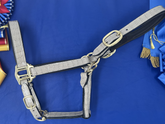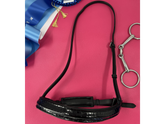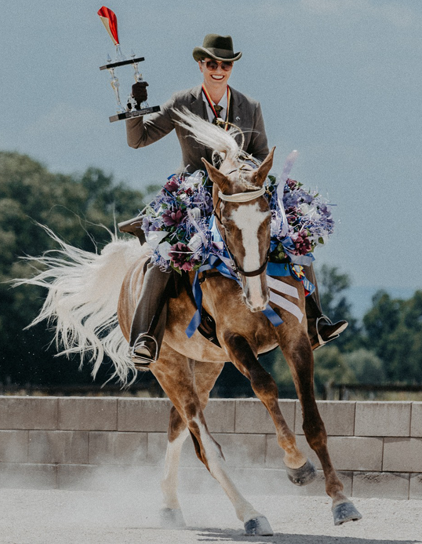WOW Saddles Feature Insertable Seat Bone Shims to Correct Rider Asymmetry
Welcome to Delfina Saddlery, your online destination for all things equestrian and beyond! Today, we're diving deep into the world of WOW Saddles and their "Pointless Panel System." As a leading provider of English tack, vegan leather horse gear, and unique, handmade, custom human accessories, we've seen our fair share of innovative (and not-so-innovative) designs in the equine industry. But WOW Saddles' PPS stands alone as the best (and we think you'll agree).
Why you can trust us:
We are the only Authorized Wow Retailer and Certified Wow Saddle Fitters in California, Nevada, Oregon, and Arizona.
Our Owner is a lifelong horsewoman, with 39 years in the saddle and a degree in Equine Science from Virginia Intermont
We spent 23 years owning and operating our own hunter/jumper training facility, producing top Junior FEI riders, Medal winners, and more
Delfina Saddlery has been making and selling custom tack and leather accessories for other horsemen and women for 12 years
Want to know more? Visit our store
Table of Contents
Seat Bone Shims (SBS)
WOW™ is the only saddle that allows the seat of the saddle to be adjusted to compensate for rider asymmetry. Every WOW Saddle has a slot on either side of the underside of the seat that allows you to insert one of their patented Seat Bone Shims (SBS).
After two decades of research on professional and amateur riders, WOW discovered that less than 1% of riders sit on both seatbones with equal force. While there are curious patterns in rider preferences from specific countries, the normal pattern for American riders is to hold the right seatbone is higher with more pressure on the left seatbone. This causes the rider to sit/fall to the right. This in turn encourages the horse's own natural asymmetry, which is typically to prefer using their right-hind leg to create impulsion. This leads to a preference for right bend in walk and trot and left lead in canter. But, by balancing the riders' asymmetry, the horse is encouraged to become more symmetrical themselves and is less hampered by an unstable rider.
Even professional riders have this problem, they are just better at masking it than most.
Available in 2, 3, 4, or 5mm thicknesses, a Seat Bone Shim may be used on either the left or right side of your WOW's seat. While you won't notice it inserted, you will notice the difference in your seat and legs.

Rider Asymmetry
Rider asymmetry may be difficult to spot with the naked eye, but use of sensitive pressure-testing equipment easily displays areas of higher- or lower-pressure. It may seem like not such a big deal, but a rider placing even the slightest bit more weight on a seat bone causes a chain reaction throughout their body and down into their horse. There are multiple reasons why riders ride asymmetrically;
- their own body's conformation and ability to fit their horse
- acute and/or chronic injuries of the rider
- subconsciously attempting to compensate for their horse's asymmetry
- saddle fit
- saddle design
- saddle position
- the propulsive forces transmitted to the rider from the horse and the rider's ability to absorb those forces
In addition to the rider's technical abilities, humans are born with their own function skeletal asymmetries (MacKechnie-Guire, et al), and there is absolutely nothing you can do to fix these. They are simply a part of being a living, breathing organism.
Are your own struggles in the saddle being caused by asymmetry? If you:
- Notice one of your legs hangs better around your horse's rib cage
- Struggle to keep one of your feet in the stirrup
- Feel as though one of your legs is 'scrunched' up
- Experience consistent saddle slip to one side, even on different horses
- Notice the knee and toes of one leg points forward, while the other knee and toes point slightly away from your horse
- Notice every horse you ride prefers going the same direction
- Notice your horse's coat has asymmetrical hair wear on one side of their back
You are probably suffering from rider asymmetry and sitting unevenly on your seat bones.

Correcting rider asymmetry in the saddle isn't just an important key to unlocking more effective equitation; rider asymmetry in the saddle actually has a deleterious effect on your horse. Over time, your own rider asymmetry can lead to chronic front- and hind-leg lameness.
A recent study looked into the effect Rider Asymmetry had on Equine Movement. When the rider's short side was to the outside, an increase in maximum fetlock extension was apparent for both the inside front and hind legs. When the rider's shorter side was on the inside, an increase in flexion-extension at T5 and L3 was present, as well as axial rotation at T5. Lateral bending of T5, L3, and TS was also seen. Over time, the increased loading on the joints of the leg and twisting of the spinal vertebrae will lead to front- and hind-limb lameness and injuries, and chronic soft-tissue injury of the horse's back.
Consistent Saddle Slip as an Indicator of Lameness
Asymmetries related to the horse's back shape and movement have been shown to induce saddle slip [4]. In this study, observed saddle slip (defined as a consistent slip to one side) was highly related to hindlimb lameness and associated with thoracolumbar shape and a crooked seat of the rider. The same study reported asymmetrical hair wear in horses with asymmetrical saddle movement, indicating chronic, asymmetric forces exerted on the horse's back. And what's on the horse's back? That's right - you and your saddle.
In this study evaluating the interrelationship of lameness, saddle slip, and back shape in the general sporthorse population, researchers evaluated 506 sporthorses in normal work. The study concluded that 45% of the study horses presented with a reduced stride length and/or a stiff, stilted canter. 12% of these horse's riders complained of consistent saddle slip to one side. Researchers found that in 24.4% of horses with a hind-limb lameness and 45.5% of horses with both front- and hind-limb lameness, the saddle consistently slipped to one side. Saddle slip to one side was only seen in 5.5% of healthy, non-lame horses. Nineteen horses with saddle slip had no detectable limb lameness; however, 14 of these horses did have detectable gait abnormalities, particularly in the canter. It is not known whether these 14 horses eventually developed some type of lameness or injury later.
Based on several published studies of rider asymmetry, saddle slip, and limb soundness in ridden horses, we can draw several conclusions:
- Rider asymmetry leads to an uneven loading of pressure across a horse's back
- This unequal loading of weight on the horse causes excess forces that travel through the horse's body, causing an increase in joint extension and flexion on the side with extra weight
- Over time, this uneven loading of pressure causes soft-tissue damage to the muscles supporting the horse's spine
- Eventually, soft-tissue injury to the limbs on the side carrying additional weight lead to front- and/or hind-limb lameness
And, most importantly:
- Consistent saddle slip to one side is one of the greatest indicators of hindlimb lameness

Correcting Rider Asymmetry
As this issue gains attention, several companies have come up with novel approaches to correcting rider asymmetry. All manner of bands, ties, loops, and belts clutter the market, and most aren't worth their price in shipping. The only other product on the market I have seen that addresses the root cause of rider asymmetry is ThinLine's English Saddle Seat Saver. This product was not initially created to address rider asymmetry, but has evolved to allow a shim to be installed. Below, the leg strap product is still undergoing testing and has yet to hit the market, while the ThinLine English Seat Saver is available for purchase now.


WOW's Solution
WOW's patented Seat Bone Shims were created specifically to address rider asymmetry in the saddle. The Seat Bone Shim can be quickly and easily installed with only a screwdriver. The shim (or 'paddle') is a piece of plastic 2, 3, 4, or 5mm thick, that is inserted between the seat and the tree. The shim cannot be felt by the rider directly; however, riders absolutely feel the difference in their own bodies once one is installed. Not only does the shim lift the seat up just enough to meet the rider's higher and lighter seat bone, doing so immediately:
- Allows the 'scrunched' leg to relax
- Allows the torso and hips to sit straight in the saddle
- Allows the weaker leg to lay flat against the horse with knees and toes pointing more forward
- Enables riders to keep both of their stirrups while riding
- Corrects consistent saddle slip to one side due to asymmetrical loading of the rider's weight in the saddle
- Adds confidence in the weaker direction
- Halts the chain reaction between rider asymmetry:chronic equine lameness
This chain reaction of positive changes is only possible in a WOW saddle.

Frequently Asked Questions
Do all riders suffer from asymmetry in the saddle?
WOW and other researchers have concluded massive studies on rider asymmetry in the saddle and its effects on horses. WOW found, after years of evaluating riders with very sensitive pressure-measuring mats, that less than 1% of riders sit perfectly symmetrical in the saddle.
How do I know if I suffer from seat bone asymmetry?
There are a lot of indicators that tell us you may be sitting asymmetrically in the saddle. Some of these include:
- One of your legs hangs better around your horse's rib cage
- You struggle to keep one of your feet in the stirrup
- You feel as though one of your legs is 'scrunched' up
- You experience consistent saddle slip to one side, even on different horses
- The knee and toes of one leg point forward, while the other knee and toes point slightly away from your horse
- You notice every horse you ride prefers going the same direction
- You notice your horse's coat has asymmetrical hair wear on one side of their back
Are there any exercises I can do to correct asymmetry in the saddle?
Rider asymmetry in the saddle is usually caused by skeletal (and/or muscular) imbalances. While it certainly helps to have a well-qualified coach that can not only spot when you're sitting asymmetrically in the saddle, but help you figure out how to compensate for doing so, there is nothing you can do to change how your skeleton is put together. The best solution to correct your imbalances in the tack is to try out a WOW Saddle with a Seat Bone Shim inserted. Doing so will enable you to sit properly in the saddle with your weight evenly distributed over your horse, and allow you to focus on bigger things (like sorting out that whole inside-leg-to-outside-rein thing your coach has been yelling about for six years).














Leave a comment
Please note, comments need to be approved before they are published.